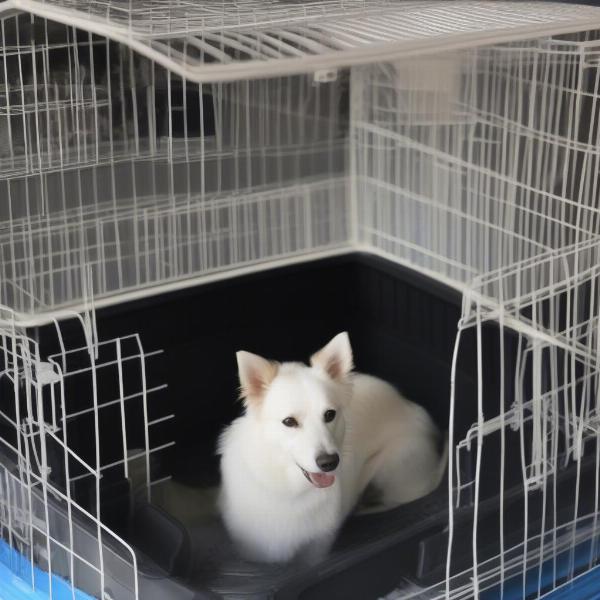Plastic dog cages offer a lightweight, portable, and often more affordable option compared to metal or wire crates. They are particularly useful for travel, temporary confinement, or as a den-like space for smaller dogs. However, choosing the right plastic dog cage requires careful consideration of your dog’s size, breed, and temperament. This guide will cover everything you need to know about selecting, using, and maintaining a plastic dog cage.
Choosing the Right Plastic Dog Cage
Selecting the appropriate plastic dog cage is crucial for your dog’s comfort and safety. Consider these factors:
- Size: The cage should be large enough for your dog to stand up, turn around, and lie down comfortably. Measure your dog and add a few inches to determine the appropriate dimensions. A cage that’s too small can be restrictive and stressful, while one that’s too large might not provide the den-like security some dogs prefer.
- Ventilation: Adequate ventilation is essential. Look for cages with plenty of ventilation holes on the sides and back. This ensures proper airflow and prevents overheating, especially in warmer climates.
- Durability: Opt for a sturdy, durable cage made from high-quality, non-toxic plastic. Check for reinforced corners and latches to withstand chewing and prevent escapes. A robust cage will provide long-lasting use and ensure your dog’s safety.
- Security: Secure latches are vital to prevent your dog from escaping. Ensure the latches are easy for you to operate but difficult for your dog to manipulate. Double-check the latches regularly to ensure they remain secure.
Advantages and Disadvantages of Plastic Dog Cages
Like any product, plastic dog cages have their pros and cons. Understanding these can help you make an informed decision.
Advantages:
- Lightweight and Portable: Plastic cages are generally lighter than metal alternatives, making them easier to transport and move around. This is especially beneficial for travel.
- Easy to Clean: The smooth surfaces of plastic cages make cleaning simple. Most can be wiped down with soap and water or disinfected with pet-safe cleaners.
- Variety of Designs and Colors: Plastic cages are available in various colors and styles to match your home décor. Some even feature integrated food and water bowls.
- Affordability: Plastic cages are often less expensive than metal or wire crates, making them a budget-friendly option.
Disadvantages:
- Less Durable than Metal: While durable plastic options exist, they are generally not as sturdy as metal cages. They can be susceptible to cracking or breaking, especially with determined chewers.
- Less Ventilation than Wire Crates: While well-ventilated plastic cages exist, they typically offer less airflow than wire crates. This is something to consider, especially if you live in a hot climate.
- Not Ideal for Strong Chewers: For dogs prone to chewing, plastic cages might not be the best choice. They can chew through the plastic, posing a safety hazard.
 Pros and Cons of Plastic Dog Cages
Pros and Cons of Plastic Dog Cages
Cleaning and Maintaining Your Plastic Dog Cage
Regular cleaning is essential to keep your dog’s cage hygienic and odor-free.
- Daily Spot Cleaning: Remove any soiled bedding, food spills, or accidents promptly.
- Weekly Deep Cleaning: Remove all bedding and wash it thoroughly. Wash the cage with soap and water, rinse thoroughly, and allow it to dry completely before reintroducing bedding.
- Disinfection: Regularly disinfect the cage with a pet-safe disinfectant to kill bacteria and germs.
Are Plastic Dog Cages Right for Your Dog?
Plastic dog cages can be a great option for certain dogs and situations. They are particularly suitable for smaller breeds, travel, or temporary confinement. However, they might not be the best choice for large or strong chewers. Consider your dog’s individual needs and temperament when making your decision.
Conclusion
Choosing the right plastic dog cage requires careful consideration of your dog’s size, breed, and chewing habits. By understanding the advantages and disadvantages and following the cleaning and maintenance tips, you can ensure your dog’s comfort and safety in their plastic cage. Remember to prioritize proper ventilation, security, and size when making your selection. A well-chosen plastic dog cage can provide a secure and comfortable space for your furry friend.
FAQ
- Are plastic dog cages safe for puppies? Yes, they can be safe for puppies, provided they are appropriately sized and the puppy is not a strong chewer.
- Can I use a plastic dog cage for air travel? Yes, many airlines approve specific types of plastic dog cages for air travel. Check with your airline for their specific requirements.
- How do I prevent my dog from chewing on their plastic cage? Provide plenty of chew toys and mental stimulation to redirect their chewing behavior.
- What size plastic dog cage should I get for my dog? Measure your dog’s height, length, and width and add a few inches to determine the appropriate size.
- Can plastic dog cages be used outdoors? Some plastic cages are designed for outdoor use, but ensure they provide adequate shade and protection from the elements.
Related Articles
ILM Dog is a leading international website dedicated to providing expert advice and resources on dog care and breeding. We offer comprehensive information on a wide range of topics, including breed selection, health care, training, nutrition, grooming, and product recommendations. From choosing the right plastic dog cage to understanding your dog’s nutritional needs, ILM Dog is your trusted source for all things canine. Contact us today for expert advice at [email protected] or +44 20-3965-8624. Visit us at ILM Dog for more information.